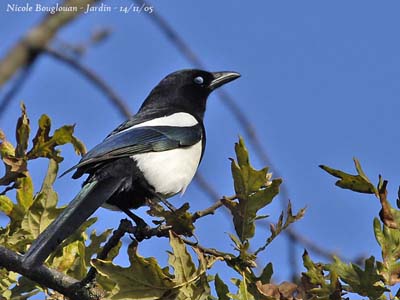
Eurasian Magpie
Pica pica
Passeriforme Order – Corvidae Family
BIOMETRICS:
Length: 46-50 cm
Wingspan: 56-61 cm
Weight: M : 185-245 g – F : 160-240 g
DESCRITION:
Eurasian Magpie is a black and white long-tailed bird. Adult has black head, chest, back and vent, with iridescent metallic blue-green wings and tail. It has large white patches on scapulars and white markings on primaries visible on extended wings. Belly is pure white. Tail is long, graduated, with a glossy purple band near the tip.
Fr: Pie bavarde
All : Elster
Esp : Urraca Común
Ital : Gazza comune europea
Nd: Ekster
Russe: Сорока
Sd: Skata
Text and photographs by Nicole Bouglouan
Sources :
HANDBOOK OF THE BIRDS OF THE WORLD Vol 14 by Josep del Hoyo-Andrew Elliot-David Christie - Lynx Edicions –
ISBN: 9788496553507
THE HANDBOOK OF BIRD IDENTIFICATION FOR EUROPE AND THE WESTERN PALEARCTIC by Mark Beaman, Steve Madge - C.Helm - ISBN: 0713639601
THE COMPLETE BOOK OF BRITISH BIRDS – Written by “Royal Society for the Protection of Birds” experts - Préface de Magnus Magnusson - Michael Cady- Rob Hume Editors - ISBN: 0749509112
Wikipedia (Wikipedia, The Free Encyclopedia)
Arthur Grosset's Birds (Arthur Grosset)

The strong bill is black. Eyes are dark brown. Legs and feet are blacks.
Both sexes are similar in plumage, but male is larger than female.
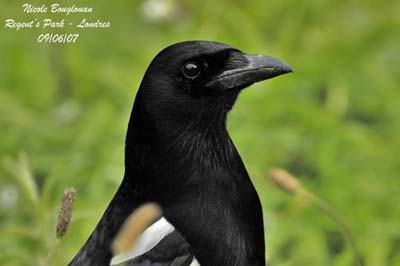
Juvenile resembles adults with duller plumage, less glossy feathers and shorter tail.
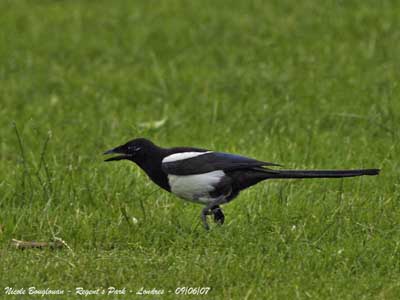
We find several races sharing the wide range. They differ in intensity of gloss in the black areas, wing pattern and tail length and size.
VOICE: SOUNDS BY XENO-CANTO
Eurasian Magpie’s common call is a harsh chattering “chack-chack-chack-chack-chack”. It is very noisy when in groups, uttering rapid, nasal “mag? mag? mag?” or “yak-yak-yak”.
HABITAT:
Eurasian Magpie lives in farmlands, thickets, open or lightly wooded areas, meadows and mountainsides, parks and gardens, even in town.
RANGE:
Eurasian Magpie lives in Eurasia, from Western Europe to Japan and Northern Africa.
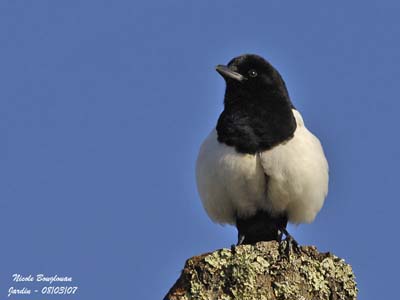
BEHAVIOUR:
Eurasian Magpie is often associated with cattle, perching on their backs, picking off ticks. It usually forages on the ground, searching for insects. It often stores food, making a small hole with the bill in the ground, and regurgitating food in it. Then, it covers the hole for one or two days, and later use.
Eurasian Magpie is sometimes comical on the ground. It walks with high steps, and often hops sideways when excited. On the ground, the tail is held elevated, rarely spread.
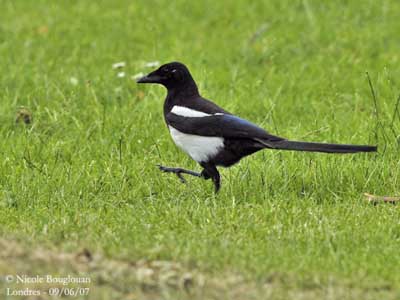
Eurasian Magpie forms long-term bonds. Courtship displays include courtship feeding to female by male. They are monogamous, and they generally nest solitary, but they may be found in loose colonies.
They are gregarious outside breeding season. Noisy groups gather in winter, chasing around the branches, and performing displays while calling. They follow predators and may steal food from other species.
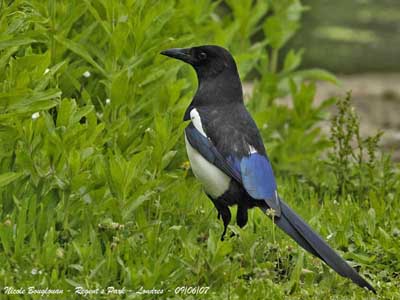
Eurasian Magpie is resident all year round in its range, but some birds may move southwards or to lower elevations in winter.
FLIGHT:
Eurasian Magpie performs direct flight with slow steady wing beats. Its flight is weaker than other corvid, and rather unsteady because the long tail. It performs undulating flight between trees.
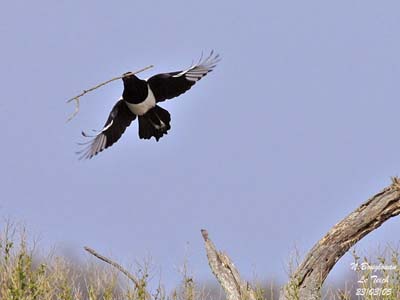
REPRODUCTION:
Both adults build the nest and need five or six weeks. It is a mud bowl lined with grass, rootlets and hair, within a large and bulky domed structure, made with strong twigs, sometimes thorny twigs. Nest has two entrances and is located in trees or bushes, at a few metres above the ground.

Female lays 4 to 9 green grey eggs, with dark brown speckles. Incubation lasts about 16 to 21 days, by female. She is fed by the male during this period. Both parents feed the altricial chicks, and male protects the nest.
Young fledge at about 25 to 29 days of age. They have a weak flight, and they quickly hide into the foliage. Family groups remain together until autumn.
This species produces one brood per season.
The nest may be parasitized by Great Spotted Cuckoo.

DIET:
Eurasian Magpie is omnivorous, feeding mainly on insects. But it also consumes conifer seeds after breeding period. It may eat berries, nuts and other seeds in winter. They also eat carrion, chicks and eggs in other species nests, and small rodents.
PROTECTION / THREATS / STATUS:
Eurasian Magpie is still considered as a pest, and may be killed in some areas. They also are vulnerable to pesticides. However, populations remain common and widespread.

Sequence of 15 pictures
